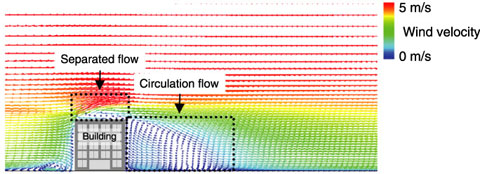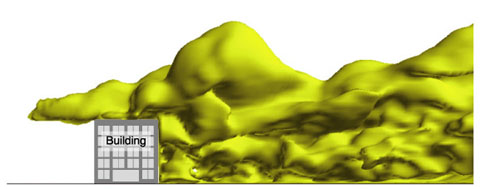
Fig.7-23 Mean wind velocity vectors around a building

Fig.7-24 Three-dimensional structure of a plume around a building
The subway hazardous gas attack in Tokyo in 1995 and terrorist attacks on major cities in the United States in 2001 have spawned concerns about various possible forms of terrorism, including airborne/aerosolized radioactive and chemical agent attacks. Owing to the increasing threat of various forms of terrorisms, we have the urgent task of planning disaster prevention against accidental and intentional release of radioactive and chemical materials within urban areas. Atmospheric dispersion is influenced by meteorological disturbances and turbulence produced by urban buildings. Therefore, an approach that involves a combination of numerical weather predictions and computational fluid dynamics models would show promise for the prediction of plume dispersion of hazardous materials within urban areas under real meteorological conditions. However, many researchers have adopted time-averaged types of turbulence models. These turbulence models are practical, but cannot accurately simulate complex turbulent flow, such as separated and circulation flows around buildings, or capture peak concentrations. For the assessment of human health hazards from toxic substances, the existence of high concentration peaks in a plume should be considered. In such a situation, unsteady behaviors of a plume cannot be captured by typical atmospheric dispersion models.
We have developed a LOcal-scale High-resolution DIspersion Model using Large-Eddy Simulation (LOHDIM-LES) for predicting plume dispersion within urban areas in order to solve the above-mentioned problems. It is well known that an LES model can give detailed information on unsteady behaviors of turbulent flow and plume dispersion. The application of an LES model is expected to facilitate the prediction of not only mean concentrations but also peak concentrations.
As the first step, we attempted to carry out the LES of turbulent dispersion around a building. Figs.7-23 and 7-24 show mean wind vectors and the three-dimensional structure of a plume. Reversed and circulation flows were formed at the roof of and behind the building, respectively. Therefore, first, a plume impinges on the building, and it is then entrained into the wake region owing to the circulation flow. We succeeded in obtaining results comparable to wind tunnel experimental results.
Thus, we have validated the basic performance of the LES atmospheric dispersion model. In a future work, we shall extend the model for the prediction of plume dispersion within actual urban areas.